当前位置:网站首页>5.4-5.5
5.4-5.5
2022-07-03 14:50:00 【III VII】
5.4 Server basic framework and event processing mode
5.4.1 Basic framework
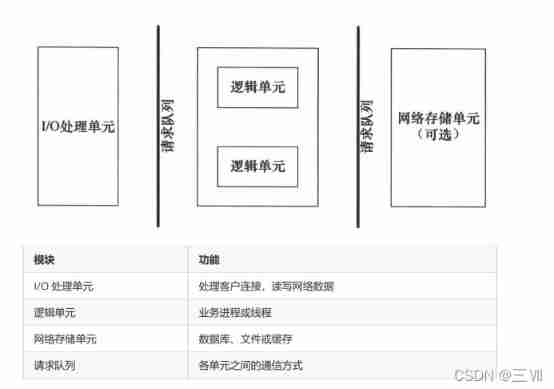
I/O The processing unit is a module for the server to manage client connections . It usually does the following : Wait and accept new customer connections , Receive customer data , Return the server response data to the client . But the sending and receiving of data is not necessarily in I/O Execute in the processing unit , It is also possible to perform... In a logical unit , Where it is executed depends on the event handling mode .
A logical unit is usually a process or thread . It analyzes and processes customer data , Then pass the result on to I/O The processing unit may send it directly to the client ( Which method to use depends on the event processing mode ). Servers usually have multiple logical units , To realize the concurrent processing of multiple customer tasks .
The network storage unit can be a database 、 Cache and file , But it's not necessary .
The mode of communication between units is abstract .I/O When the processing unit receives a customer request , A logical unit needs to be notified in some way to process the request . Again , Multiple logical units access one storage sheet at the same time
Yuan time , It is also necessary to adopt some mechanism to coordinate and deal with race conditions . Request queues are usually implemented as part of a pool .
5.4.2 Two efficient event processing modes
Server programs usually need to handle three types of events :I/O event 、 Signals and timing events . There are two efficient event handling modes :Reactor and Proactor, Sync I/O Models are often used to implement Reactor Pattern , asynchronous I/O Models are often used to implement Proactor Pattern .
Reactor Pattern
Main thread required (I/O processing unit ) Only listen for events on the file descriptor , If so, immediately notify the worker thread of the event ( Logical unit ), take socket Put readable and writable events into the request queue , Leave it to the worker thread . besides , The main thread doesn't do any other substantive work . Read and write data , Accept new connection , And processing customer requests are done in the worker thread .
Use synchronization I/O( With epoll_wait For example ) Realized Reactor The workflow of the pattern is :
- Main route epoll Register in the kernel event table socket Read ready event on .
- Main thread call epoll_wait wait for socket There's data to read on .
- When socket When there is data to read on , epoll_wait Notification thread . The main thread will socket Put readable events into the request queue .
- A worker thread sleeping on the request queue is awakened , It is from socket Reading data , And handle customer requests , Then go to epoll
Register the... In the kernel event table socket Write ready event on . - When the main thread calls epoll_wait wait for socket Can write .
- When socket Writable time ,epoll_wait Notification thread . The main thread will socket Writable events are put into the request queue .
- A worker thread sleeping on the request queue is awakened , It went to socket Write the result of the server processing the client request .
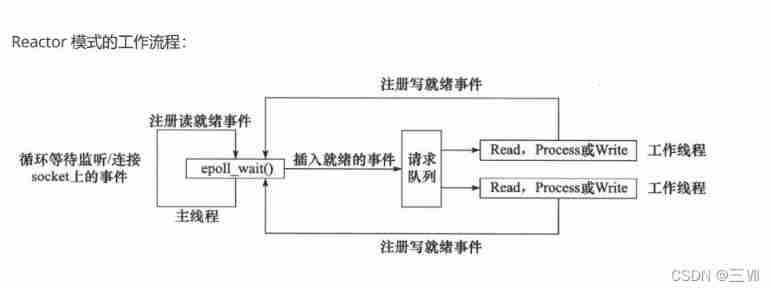
Proactor Pattern
Proactor Mode will all I/O All operations are handled by the main thread and the kernel ( Read 、 Write ), Worker threads are only responsible for business logic . Use asynchronous I/O Model ( With aio_read and aio_write For example ) Realized Proactor The workflow of the pattern is :
- Main thread call aio_read Function registers with the kernel socket Read completion event on , And tell the kernel user the location of the read buffer , And how to notify the application when the read operation is completed ( Take the signal as an example ).
- The main thread continues to process other logic .
- When socket After the data on is read into the user buffer , The kernel will send a signal to the application , To notify the application that the data is available .
- The pre-defined signal processing function of the application selects a worker thread to process the client request . After the worker thread processes the client request , call aio_write Function registers with the kernel socket Write completion event on , And tell the kernel user the location of the write buffer , And how to notify the application when the write operation is completed .
- The main thread continues to process other logic .
- When the data in the user buffer is written socket after , The kernel will send a signal to the application , To notify the application that the data has been sent .
- The pre-defined signal processing function of the application selects a working thread to deal with the aftermath , For example, decide whether to close socket.
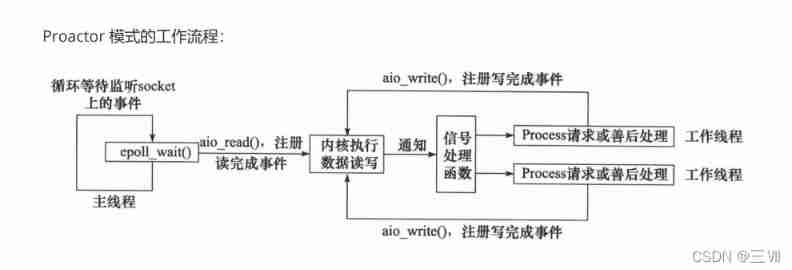
difference : Whether the worker thread needs to read and write ;
simulation Proactor Pattern
Use synchronization I/O Mode simulation Proactor Pattern . The principle is : The main thread performs data read and write operations , After reading and writing , The main thread notifies the worker of this ” Completion event “. So from the perspective of worker threads , They directly get the results of data reading and writing , The next thing to do is to logically process the results of reading and writing .
Use synchronization I/O Model ( With epoll_wait For example ) Simulated Proactor The workflow of the mode is as follows :
- Main route epoll Register in the kernel event table socket Read ready event on .
- Main thread call epoll_wait wait for socket There's data to read on .
- When socket When there is data to read on ,epoll_wait Notification thread . The main thread is from socket Loop read data , Until no more data is readable , Then the read data is encapsulated into a request object and inserted into the request queue .
- A worker thread sleeping on the request queue is awakened , It gets the request object and processes the customer request , Then go to epoll Register in the kernel event table socket Write ready event on .
- Main thread call epoll_wait wait for socket Can write .
- When socket Writable time ,epoll_wait Notification thread . Main route socket Write the result of the server processing the client request .
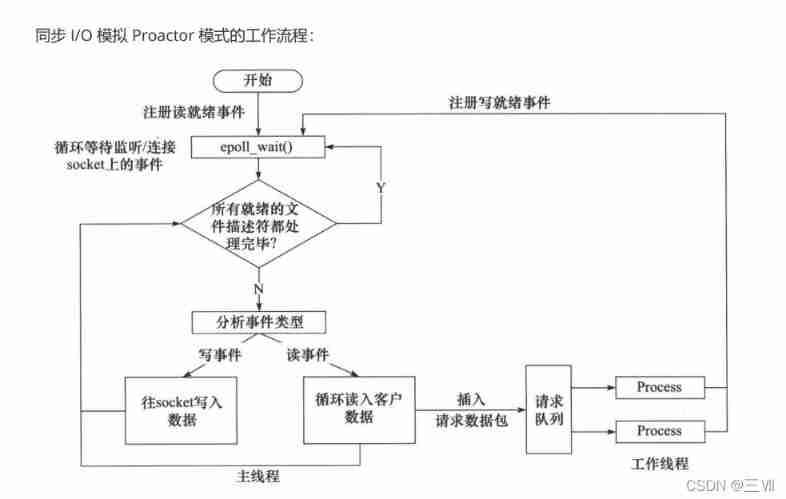
5.5 Thread pool
A thread pool is a set of child threads created in advance by the server , The number of threads in the thread pool should be the same as CPU It's about the same amount . All child threads in the thread pool run the same code . When a new task comes , The main thread will select a child thread in the thread pool to serve it in some way . Compared with the dynamic creation of sub threads , The cost of selecting an existing child thread is obviously much smaller . As for which sub thread the main thread chooses to serve the new task , There are many ways :
- The main thread uses some algorithm to actively select sub threads . The most simple 、 The most commonly used algorithms are random and Round
Robin( Take turns choosing ) Algorithm , But better 、 Smarter algorithms will allow tasks to be distributed more evenly across worker threads , So as to reduce the overall pressure of the server . - The main thread and all child threads share a work queue , All child threads sleep on the work queue . When a new task comes , The main thread adds a task to the work queue . This will wake up the child thread waiting for the task , However, only one child thread will get the new task ” Take over “, It can take tasks out of the work queue and execute them , While other child threads will continue to sleep on the work queue .
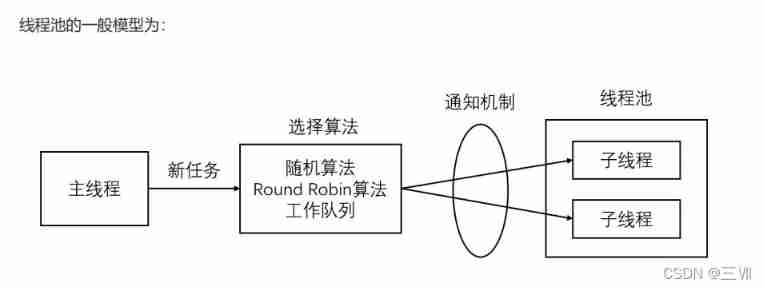
The most direct limiting factor for the number of threads in the thread pool is the CPU (CPU) The processor of (processors/cores) The number of N : If your CPU yes 4-cores Of , about CPU Intensive tasks ( Such as video clips, etc CPU The task of computing resources ) Come on , The number of threads in the thread pool should also be set to 4( perhaps +1 Prevent thread blocking caused by other factors ); about IO Intensive tasks , Generally more than CPU The number of nuclear , Because the competition between threads is not CPU Instead of computing resources IO,IO Processing is generally slow , More than cores The number of threads will be CPU Strive for more tasks , Not to thread processing IO Caused by the process of CPU Idleness leads to a waste of resources . - Space for time , Waste the hardware resources of the server , In exchange for operational efficiency .
- A pool is a collection of resources , This set of resources is completely created and initialized at the beginning of server startup , This is called static resources .
- When the server enters the formal operation stage , When you start processing customer requests , If it needs relevant resources , You can get... Directly from the pool , No need for dynamic allocation .
- When the server has finished processing a client connection , You can put related resources back into the pool , There is no need to perform a system call to free up resources .
Thread pool code
threadpool.h
#ifndef THREADPOOL_H
#define THREADPOOL_H
#include <list>
#include <cstdio>
#include <exception>
#include <pthread.h>
#include "locker.h"
template<typename T>
class threadpool{
public:
/*thread_number Is the number of threads in the thread pool ,max_requests Is the maximum number of... Allowed in the request queue 、 Number of requests waiting to be processed */
threadpool(int thread_number = 8, int max_requests = 10000);
~threadpool();
bool append(T* request);
private:
/* Functions run by worker threads , It constantly takes tasks from the work queue and executes them */
static void* worker(void* arg);
void run();
private:
// Number of threads
int m_thread_number;
// An array describing the thread pool , The size is m_thread_number
pthread_t * m_threads;
// Maximum allowed in the request queue 、 Number of requests waiting to be processed
int m_max_requests;
// Request queue
std::list< T* > m_workqueue;
// Protect the mutex of the request queue
locker m_queuelocker;
// Is there a task to deal with
sem m_queuestat;
// End thread or not
bool m_stop;
};
// Concrete realization
template <typename T>
threadpool< T >::threadpool(int thread_number, int max_requests) :
m_thread_number(thread_number), m_max_requests(max_requests),
m_stop(false), m_threads(NULL) {
if((thread_number <= 0) || (max_requests <= 0) ) {
throw std::exception();
}
m_threads = new pthread_t[m_thread_number];
if(!m_threads) {
throw std::exception();
}
// establish thread_number Threads , And set them to be out of thread .
for ( int i = 0; i < thread_number; ++i ) {
printf( "create the %dth thread\n", i);
if(pthread_create(m_threads + i, NULL, worker, this ) != 0) {
delete [] m_threads;
throw std::exception();
}
// Set thread separation ;
if( pthread_detach( m_threads[i] ) ) {
delete [] m_threads;
throw std::exception();
}
}
}
// Destructor
template< typename T >
threadpool< T >::~threadpool() {
delete [] m_threads;
m_stop = true;
}
template< typename T >
bool threadpool< T >::append( T* request )
{
// Be sure to lock the work queue , Because it is shared by all threads .
m_queuelocker.lock();
if ( m_workqueue.size() > m_max_requests ) {
m_queuelocker.unlock();
return false;
}
m_workqueue.push_back(request);
m_queuelocker.unlock();
m_queuestat.post();
return true;
}
template< typename T >
void* threadpool< T >::worker( void* arg )
{
threadpool* pool = ( threadpool* )arg;
pool->run();
return pool;
}
template< typename T >
void threadpool< T >::run() {
while (!m_stop) {
m_queuestat.wait();// Judge whether there is a task to do
m_queuelocker.lock();
if ( m_workqueue.empty() ) {
m_queuelocker.unlock();
continue;
}
T* request = m_workqueue.front();
m_workqueue.pop_front();
m_queuelocker.unlock();
if ( !request ) {
continue;
}
request->process();
}
}
#endif
locker.h
#ifndef LOCKER_H
#define LOCKER_H
// Thread synchronization mechanism encapsulates classes
#include<pthread.h>
#include<exception>
#include <semaphore.h>
// Mutex class
class locker
{
private:
pthread_mutex_t m_mutex;
public:
locker(){
if(pthread_mutex_init(&m_mutex, NULL)!= 0){
throw std::exception();
}
}
~locker()
{
pthread_mutex_destroy(&m_mutex);
}
bool lock()
{
return pthread_mutex_lock(&m_mutex) == 0;
}
bool unlock()
{
return pthread_mutex_unlock(&m_mutex) == 0;
}
pthread_mutex_t *get()
{
return &m_mutex;
}
};
class cond {
public:
cond(){
if (pthread_cond_init(&m_cond, NULL) != 0) {
throw std::exception();
}
}// Initialize semaphores
~cond() {
pthread_cond_destroy(&m_cond);
}
// Destroy semaphore
bool wait(pthread_mutex_t *m_mutex) {
int ret = 0;
ret = pthread_cond_wait(&m_cond, m_mutex);
return ret == 0;
}
bool timewait(pthread_mutex_t *m_mutex, struct timespec t) {
int ret = 0;
ret = pthread_cond_timedwait(&m_cond, m_mutex, &t);
return ret == 0;
}
// With timeout
bool signal() {
return pthread_cond_signal(&m_cond) == 0;
}
bool broadcast() {
return pthread_cond_broadcast(&m_cond) == 0;
}
private:
pthread_cond_t m_cond;
};
// Semaphore class
class sem {
public:
sem() {
if( sem_init( &m_sem, 0, 0 ) != 0 ) {
throw std::exception();
}
}
sem(int num) {
if( sem_init( &m_sem, 0, num ) != 0 ) {
throw std::exception();
}
}
~sem() {
sem_destroy( &m_sem );
}
// Wait for the semaphore
bool wait() {
return sem_wait( &m_sem ) == 0;
}
// Increase the semaphore
bool post() {
return sem_post( &m_sem ) == 0;
}
private:
sem_t m_sem;
};
#endif
边栏推荐
- Use of form text box (I) select text
- 406. 根据身高重建队列
- Output student grades
- Dllexport and dllimport
- Zzuli:1040 sum of sequence 1
- China PETG market forecast and Strategic Research Report (2022 Edition)
- [qingniaochangping campus of Peking University] in the Internet industry, which positions are more popular as they get older?
- How can entrepreneurial teams implement agile testing to improve quality and efficiency? Voice network developer entrepreneurship lecture Vol.03
- Dllexport et dllimport
- Bucket sorting in C language
猜你喜欢

tonybot 人形机器人 定距移动 代码编写玩法

tonybot 人形机器人 红外遥控玩法 0630

Timecho of Tianmou technology completed an angel round financing of nearly 100 million yuan to create a native timing database of the industrial Internet of things

The picture quality has been improved! LR enhancement details_ Lightroom turns on AI photo detail enhancement: picture clarity increases by 30%

Tiantu investment sprint Hong Kong stocks: asset management scale of 24.9 billion, invested in xiaohongshu and Naixue
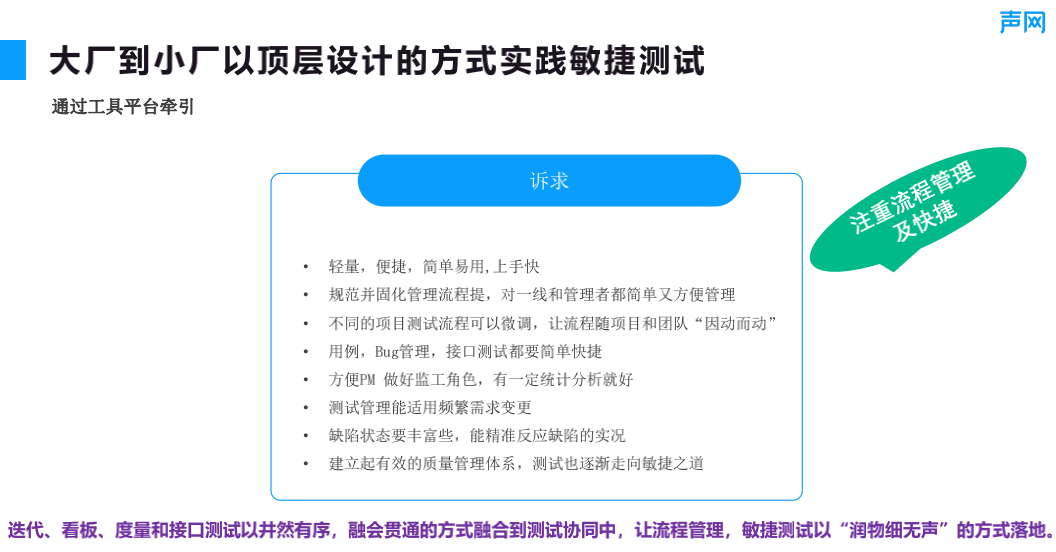
How can entrepreneurial teams implement agile testing to improve quality and efficiency? Voice network developer entrepreneurship lecture Vol.03
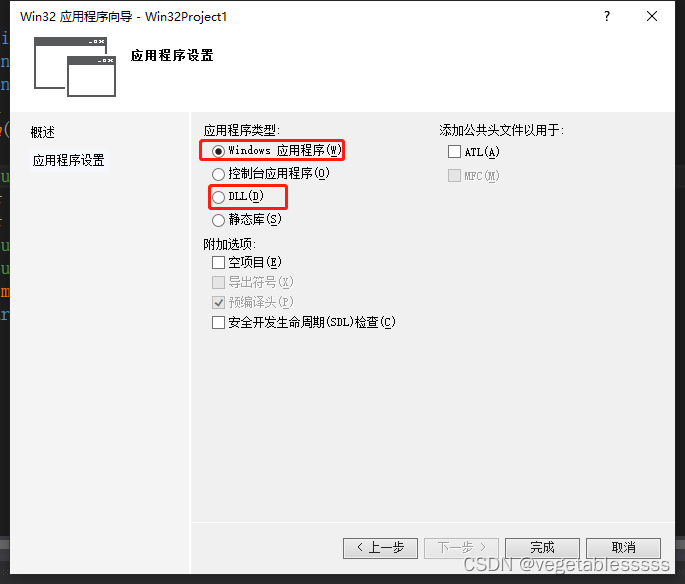
Dllexport et dllimport

How to query the baby category of tmall on Taobao
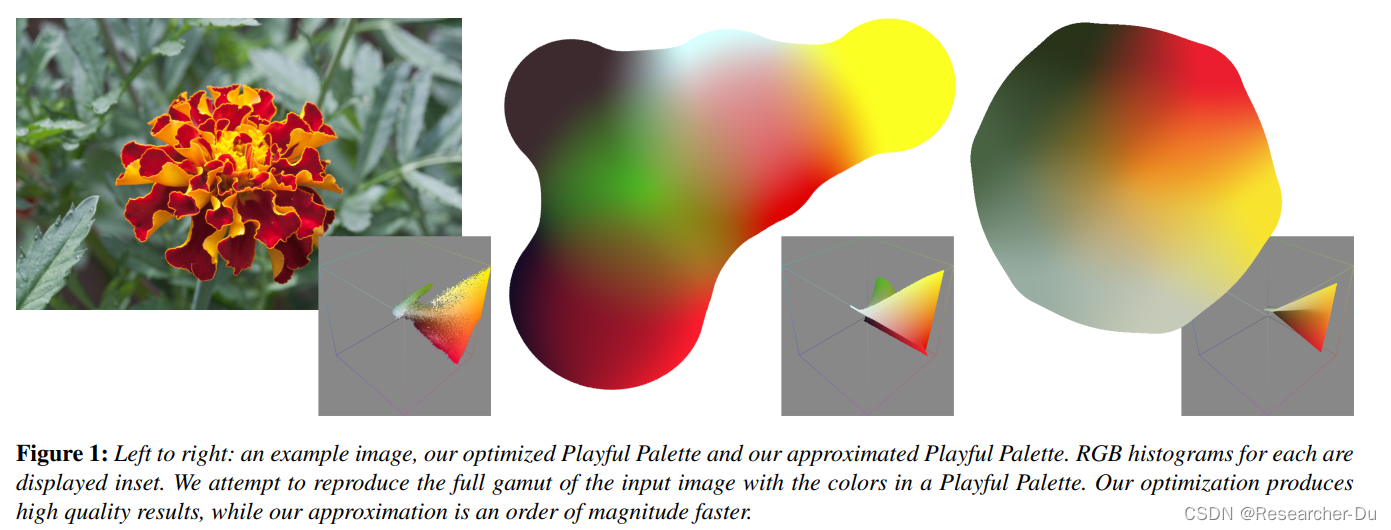
Paper sharing: generating playful palettes from images
![Luogu p5018 [noip2018 popularization group] symmetric binary tree problem solution](/img/89/da1a3a38e02671628f385de0f30369.png)
Luogu p5018 [noip2018 popularization group] symmetric binary tree problem solution
随机推荐
Optical cat super account password and broadband account password acquisition
Container of symfony
On MEM series functions of C language
FPGA blocking assignment and non blocking assignment
tonybot 人形機器人 紅外遙控玩法 0630
Fundamentals of PHP deserialization
cpu飙升排查方法
How to color ordinary landscape photos, PS tutorial
Sub GHz wireless solution Z-Wave 800 Series zg23 SOC and zgm230s modules
CentOS7部署哨兵Redis(带架构图,清晰易懂)
[opengl] pre bake using computational shaders
Awvs batch operation script
Pytorch深度学习和目标检测实战笔记
dllexport和dllimport
Several sentences extracted from the book "leather bag"
Yolov5进阶之七目标追踪最新环境搭建(二)
NOI OPENJUDGE 1.5(23)
tonybot 人形机器人 红外遥控玩法 0630
Qt—绘制其他东西
Protobuf and grpc